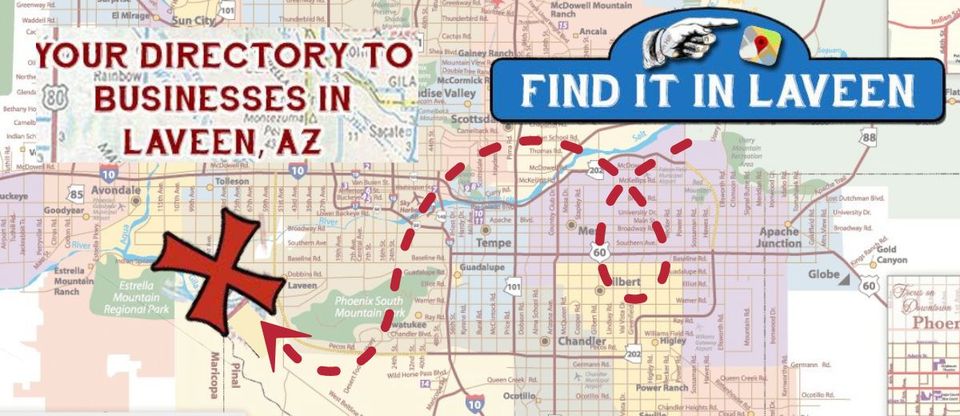This article first appeared in the October 2016 SMDN
About 200 community members turned out in late September to get their first look at design plans for the 22-mile South Mountain Freeway that will travel through Laveen at about 61st Avenue.
There was more than one pair of overalls and several cowboy hats dotting the audience, which included everyone from community leaders to farmers to local business owners, all eager to learn how the freeway project will unfold over the next three years with completion expected in 2019. Local residents asked questions about bridges, interchanges, design styles, pedestrian and bicycle access along the thoroughfare, as well as how traffic will be redirected during construction, particularly along Southern Avenue, Baseline Road and Dobbins Avenue, the main east to west corridors in Laveen.
“I think we had excellent attendance – pretty much standing room only,” said Dustin Krugel, spokesman for the Arizona Department of Transportation. “We had about 59 questions and 40 comments submitted during the evening. I think it was overwhelmingly positive. I heard from a lot of people that were saying … ‘let’s build the freeway.’”
Two hundred members of the community attended a recent ADOT meeting that helped answer questions regarding design and other items for the South Moun- tain Freeway, which began construction last month.
Krugel said the questions at the Laveen meeting focused on drainage and flood zones, noise and sound walls, Baseline Road and right-of-way questions, including acquisition and demolition. There will be about 11 miles of sound walls as part of the design, he said, though the public’s input could influence changes in the design. Another spokesman from ADOT noted that not all of right-of-ways have been secured for the entire 22-mile stretch but that the process is underway.
While residents in Laveen appear to mostly support the project opponents filed separate lawsuits seeking to stop the long-planned freeway arguing that ADOT, the Federal Highway Administration and other government entities had failed to adequately address the environmental and cultural impact of the roadway. In August, U.S. District Court Judge Diane J. Humetewa ruled in favor of transportation officials and construction started in September.
Representatives from the Gila River Indian Community and P.A.R.C. (Protecting Arizona’s Resources and Children) and their affiliated groups say they plan to pursue an appeal through the U.S. Ninth Circuit Court of Appeal in San Francisco. If they are unsuccessful in their bid to legally stop the freeway there, the next step would be to appeal to the U.S. Supreme Court.
At least one person asked about the legal status of the project during the September meeting, and ADOT officials answered that construction will continue unless there is a reversal in the current legal status.
Highlights of the presentation by the Arizona Department of Transportation and business partners:
- Construction will be happening simultaneously along the entire route with the freeway opening after all construction is done.
- The project received its first voter approval in 1985. Voters again supported the Regional Transportation Plan that includes the freeway in 2004.
- When this last portion of the Loop 202 is completed, drivers will have an alternative to crossing through the City of Phoenix using Interstate 10.
- Total project cost is $1.77 billion, the largest highway project tin state history
- The project also is the state’s largest public-private partnership in which government agencies and private sector businesses will jointly design, construct and maintain the 22-mile freeway. The main private partner is Connect 202 Partners, which is responsible for designing and building the freeway, and providing maintenance for 30 years after construction. The partners include: Fluor Enterprises Inc., Granite Construction Co. and Ames Construction Inc., with Parsons Brinckerhoff Inc. as the lead designer.
- There will be interchanges at approximately 1-mile intervals.
- The project will include about 45 bridges.
- There will be three lanes of traffic, plus an HOV lane, in both directions.
- The design introduces the innovative diverging-diamond approach to interchanges at Desert Foothills Parkway and 17th Avenue. According to a University of Missouri study, this design decreased the overall number of crashes by more than 50 percent, and the number of fatal accidents by 70 percent.
Prior to and following the presentation, community members were invited to visit a host of exhibits and work stations that ADOT representatives and numerous Connect 202 experts had set up including exhibits, videos, maps and more all around the perimeter of the multi-purpose room at Betty H. Fairfax High School.
The meeting on Sept. 28 was the second of three with the first taking place on Sept. 27 at Desert Vista High School in Ahwatukee and the last taking place Oct. 6 at Fowler Elementary School in west Phoenix. ADOT officials say the meetings are geared to provide information on the freeway’s location, profile, interchange configurations and noise barrier locations, as well as initial concepts for landscaping and visual appearance.
Construction of the South Mountain Freeway began last month with improvements to the Interstate 10/Loop 202 interchange in the East Valley. Work includes the extension of the existing Loop 202 HOV lanes and widening the shoulders from Pecos Road near 48th Street to the I-10/Loop 202 interchange. This initial phase of work will be completed prior to the construction of the mainline freeway, which is scheduled to begin in early 2017. For those unable to attend, the presentations are posted online at www.southmountainfreeway.com. The public also can provide feed- back about the design and any concerns they have through Oct. 20. Once all questions and meetings are complete, ADOT will prepare a report about the public input and share it in early November.
Related articles:
- ADOT announces legal win in South Mountain Freeway
- ADOT recaps recent public meetings on freeway
- Public input sought on South Mountain Freeway
- ADOT releases update on South Mountain Freeway project
- South Mountain Freeway Construction Starts this month



